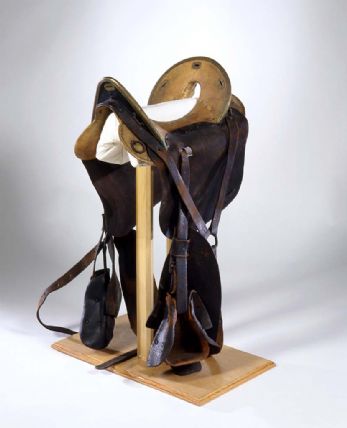As COVID-19 deaths spiked in 2020, Suzanne Firstenberg’s public art installation "In America: How could this happen…"
History Explorer Results (10)
Related Books (0)

Grade Range:
5-12
Resource Type(s):
Artifacts, Primary Sources
Date Posted:
12/28/2010
Confederate cavalry leader John Mosby is among the most romantic characters in the Civil War. From 1863 to the end of the conflict, Mosby's raiders were a constant headache for the North. The raiders usually acted in small detachments of several dozen, sacking supply depots, attacking railroads,

Grade Range:
5-12
Resource Type(s):
Artifacts, Primary Sources
Date Posted:
12/28/2010
These crutches were used by John Mosby during the Civil War. Mosby stated, “These crutches were made for me during the war by a slave named Isaac who belonged to my father. They were first used in August 1863 when I went home wounded. My mother kept them for me and I again used them in Septembe

Grade Range:
5-12
Resource Type(s):
Artifacts, Primary Sources
Date Posted:
12/21/2010
English-made Mexican cavalry flintlock carbine, .58 caliber marked with the Mexican symbol of an eagle devouring a snake.

Grade Range:
5-12
Resource Type(s):
Artifacts, Primary Sources
Date Posted:
12/17/2010
In 1855 Secretary of War Jefferson Davis was instrumental in the creation of two regiments of cavalry. It was recommended that the cavalry have a distinctive hat; it is sometimes called the Jeff Davis hat. It also was referred to as the Hardee hat, after William Joseph Hardee, an officer of the 2

Grade Range:
5-12
Resource Type(s):
Artifacts, Primary Sources
Date Posted:
12/17/2010
Captain George B. McClellan toured Europe with a military commission looking at new military tactics. He returned and developed a new modified cavalry saddle. In 1859, the U.S. War Department adopted the McClellan saddle. They remained the standard issue throughout the history of the horse cavalr

Grade Range:
K-12
Resource Type(s):
Artifacts, Primary Sources
Date Posted:
12/6/2010
According to legend, this coat was made from the skin of a buffalo killed by Buffalo Bill, and presented by him to Captain J. B. Irvine, Twenty-second U.S. Infantry. Irvine then presented it to Second Lieutenant Albert C. Dalton, Company A, U.S. Infantry.
In a life that was part le

Grade Range:
5-12
Resource Type(s):
Artifacts, Primary Sources
Date Posted:
11/30/2010
This artifact is one of three known surviving components of a suite of four, and possibly five, colors carried by the Second Regiment of Continental Light Dragoons during the Revolutionary War. Although no definitive order has survived specifying the number of colors to be carried by a regiment o

Grade Range:
K-12
Resource Type(s):
Artifacts, Primary Sources
Date Posted:
6/25/2010
This buckskin coat was worn by Custer when he was Lieutenant Colonel with the 7th U. S. Cavalry in the Dakotas. It was one of several owned and worn by Custer, who prefered to dress like a frontiersman while out West.
In 1912, Custer's widow, Elizabeth, donated this buckskin coat t

Grade Range:
2-12
Resource Type(s):
Primary Sources, Interactives & Media
Duration:
2 minutes
Date Posted:
6/21/2010
Hal Moore, the commander of a cavalry regiment, summarizes the role of the Huey in Vietnam.
This video is part of the Price of Freedom learning resources package for use with the The Soldiers Experience lesson plan. It was produced to accompany the exhibition The Price of F

Grade Range:
5-12
Resource Type(s):
Reference Materials
Date Posted:
10/14/2008
In the decades following the Civil War, the U.S. Army fought dozens of engagements with Indians in the West. This website explores Federal Indian policies and conflicts that arose as Americans flooded west into the Great Plains. Through the use of images and objects from the Museum's collections,









